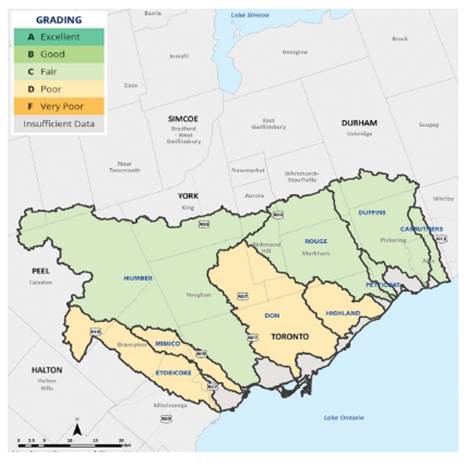
Watershed Report Cards
GTHA Poor Grade
NRU
March 28, 2018
Maryam Mirza
To commemorate World Water Day on March 22, Ontario conservation authorities released report cards outlining the health of their watersheds—and those in the GTHA received a low to fair grade. Based on four indicators—groundwater quality, surface water quality, forest conditions, and land cover—the watersheds are under distress.
The Toronto and Region Conservation Authority released 11 report cards last week: one for each of its nine watersheds, one for the Lake Ontario waterfront, and one for its entire jurisdiction, which extends from Etobicoke Creek in the west to Carruthers Creek in the east. The other GTHA conservation authorities also released report cards last week: Central Lake Ontario Conservation, Credit Valley Conservation, Halton Conservation and Hamilton Conservation.
Major contributors to the poor watershed health, according to the report cards, were land erosion due to large amounts of stormwater runoff caused by urbanization, water pollution due to fertilizer and salt carried by stormwater runoff, and poor forest conditions due to lack of natural land cover.
“There have been a lot of changes that have put a lot of pressure on our environment,” TRCA watershed planning and reporting manager Laura Del Giudice said. “Stripping the land of natural cover, leaves the soil bare, leading to [stormwater runoff picking up] high amounts of sediment in watersheds. … So it’s really important for municipalities to have strong policies that protect that natural cover as land use changes are proposed.”
Compared to previous report cards—released every five years and most recently in 2013—the conservation authorities found no significant change in watershed.
Del Guidice said that the effectiveness of policies and program on the health of the environment takes time to been seen.
“We can make investments in the ground today, but we might not see them or detect them in our monitoring for years to decades.”
Peel Region research and analysis manager Mark Head explained that the slow progress, in part, is also because implementation of new municipal methods and practices—such as low-impact development and infiltrating more stormwater into the ground—is relatively new.
“[To address] the policy gaps that we see [we need to] simply reflect that new approach in clearer language in the regional plan,” he said. “That would [enable] us to meet the provincial policy directions, and to be more current with our policies.”
Head told NRU the region’s official plan, is currently under review. This will provide an opportunity to improve policies to enhance watershed health and to provide specific policy direction with respect to implementing low-impact development and green infrastructure. He anticipates staff will be consulting the public with proposed policy amendments in 2019.
Del Giudice agrees.
“[Low-impact development measures] have proven to be effective at improving water quality, as well as, managing stormwater flows and peak flows associated with flooding, and the urban stream syndrome that can often degrade aquatic habitat,” Del Guidice said.
She said that municipalities need to continue to invest in projects to restore the natural cover in urban areas where there isn’t enough. Land acquisition is one way municipalities can help enhance watershed health.
“If adequate land can’t be secured through the land use planning process, then there should also be investments in acquiring those lands in order to ensure there is enough to support regional biodiversity, as well as, greenspace for people—because greenspace is increasingly becoming important to ensuring that human health and wellbeing is adequately considered,” Del Guidice said.
The watershed report cards also looked at high levels of chloride concentration in watersheds, mostly due to road salt used to melt ice and snow on roads.
“Chlorides have been steadily increasing in our jurisdiction and that has an impact on aquatic life,” Del Guidice said. “What’s also needed is additional attention on how to reduce the amount of salt that we put on our roads and within our parking lots.”
For instance, Mississauga works operations and maintenance director Mickey Frost told NRU that the city limits the impact of salt usage on the environment by tracking and monitoring the total amount of salt used annually, adjusting quantities to prevent overuse of salt. The city also uses magnesium chloride, a less corrosive and less environmentally harmful salt.
Additionally, Frost says, staff is currently reviewing the department’s salt management practices and anticipates reporting to general committee this fall, with the results of research into alternatives to salt, how to managing public expectations about winter maintenance and other ways to reduce the impact of salt on the environment.
According to Head, Credit Valley Conservation recently presented a report last week to council on use of road salt on private property and its impacts on aquatic resources.
“That’s something we’re just starting to take a look at—the issue of liability and how much salt used on private property that seems to lead to overuse of chloride,” he said. He added that next year staff will be investigating ways to address this issue.

